 Let’s be different and start with the non-Marvel and DC books this week; they’ve often got the most energetic and individual storytelling, and somehow always float to the top of my reading stack anyway…
Let’s be different and start with the non-Marvel and DC books this week; they’ve often got the most energetic and individual storytelling, and somehow always float to the top of my reading stack anyway…
Saga #42 — Writer: Brian K. Vaughan; Art/Colors: Fiona Staples
Hillbilly #5 — Creator: Eric Powell
Hellboy Winter Special #1 (of 1) — Writers: Mike Mignola, Chris Roberson and Scott Allie; Art: 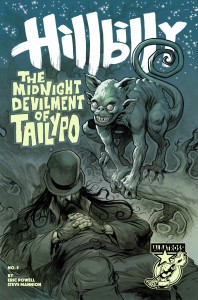 Christopher Mitten, Paul Grist and Sebastian Fiumara; Colors: Dave Stewart and Bill Crabtree
Christopher Mitten, Paul Grist and Sebastian Fiumara; Colors: Dave Stewart and Bill Crabtree
She-Wolf #5 — Creator: Rich Tommaso
Rick and Morty #22 — Writer: Kyle Starks; Art: CJ Cannon; Colors: Katy Farina
Lumberjanes #34 — Writers: Shannon Watters and Kat Leyh; Art: Carolyn Nowak; Colors: Maarta 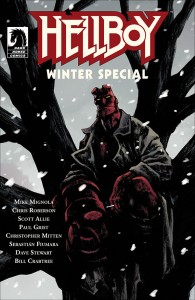 Laiho
Laiho
… like these six titles did. Saga concludes its seventh arc tragically, but boy, does it nail the presentation. If you’ve never read it before don’t start here, but go get the first trade volume; otherwise, you’re missing an intergalactic Romeo and Juliet story with cosmic sweep and memorable characters and beautiful art, and who wants to do that? Hillbilly is Southern Gothic folk tales told by Eric (The Goon) Powell, who’s just as good at this backwoods horror stuff as 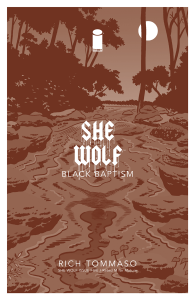 Mike Mignola; if you thought the Eisner-winning Hellboy mini-series The Crooked Man, drawn by Richard Corben, was one of the best comics of the 2000s, then you’ll get a kick out of Hillbilly. Speaking of Mignola and Hellboy, that character’s Winter Special offers three tales, two with the nicotine-addicted demon himself; the first, by Paul Grist, offers the same carefully-composed, thin-lined, modern-looking art he used to such good effect in his own Jack Staff, while the other uses more-traditional horror art, reminiscent of Gene Colan, to illustrate a haunted-woods tale that covers
Mike Mignola; if you thought the Eisner-winning Hellboy mini-series The Crooked Man, drawn by Richard Corben, was one of the best comics of the 2000s, then you’ll get a kick out of Hillbilly. Speaking of Mignola and Hellboy, that character’s Winter Special offers three tales, two with the nicotine-addicted demon himself; the first, by Paul Grist, offers the same carefully-composed, thin-lined, modern-looking art he used to such good effect in his own Jack Staff, while the other uses more-traditional horror art, reminiscent of Gene Colan, to illustrate a haunted-woods tale that covers 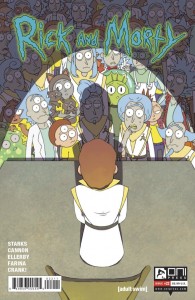 some of the same territory as The Blair Witch Project. She-Wolf mines a similar stylized-horror vein, with Tommaso’s hallucinative, minimalist art chronicling the adventures of a girl cursed by lycanthropy in her various incarnations through the centuries; it’s the kind of thing Hunter S. Thompson might have come up with after a night of binge drinking and hashish. Thompson also might have appreciated Rick and Marty, which continues to offer new stories based on the Cartoon Network cult favorite; the show’s multidimensional mythology gives the comic’s creators plenty of inspiration, as in the current arc about Morty’s dad Jerry, normally a loser in every dimension, and what happens
some of the same territory as The Blair Witch Project. She-Wolf mines a similar stylized-horror vein, with Tommaso’s hallucinative, minimalist art chronicling the adventures of a girl cursed by lycanthropy in her various incarnations through the centuries; it’s the kind of thing Hunter S. Thompson might have come up with after a night of binge drinking and hashish. Thompson also might have appreciated Rick and Marty, which continues to offer new stories based on the Cartoon Network cult favorite; the show’s multidimensional mythology gives the comic’s creators plenty of inspiration, as in the current arc about Morty’s dad Jerry, normally a loser in every dimension, and what happens 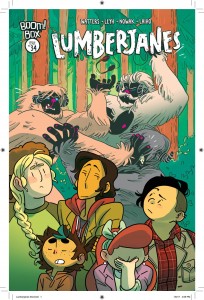 when a smart, ultra-competent Jerry from a mirror-image world shows up ands starts taking over (comics seem to be generating a lot of stories about sociopathic tyrants taking over gullible populations lately…). Lumberjanes has some cartoon DNA in it, too, although it’s an original creation; its sharply-drawn characters, emphasis on values like friendship and diversity, and clever fantasy-saturated plots would make it a good candidate for, if not an Adult Swim, then maybe a YA one, and this issue, starting a new arc involving pacifist hipster yeti and sasquatches who act like college bros on spring break, is a good sampler of its charms.
when a smart, ultra-competent Jerry from a mirror-image world shows up ands starts taking over (comics seem to be generating a lot of stories about sociopathic tyrants taking over gullible populations lately…). Lumberjanes has some cartoon DNA in it, too, although it’s an original creation; its sharply-drawn characters, emphasis on values like friendship and diversity, and clever fantasy-saturated plots would make it a good candidate for, if not an Adult Swim, then maybe a YA one, and this issue, starting a new arc involving pacifist hipster yeti and sasquatches who act like college bros on spring break, is a good sampler of its charms.
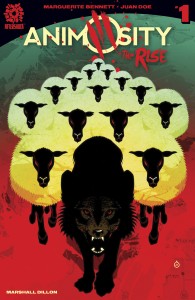 Animosity: The Rise #1 — Writer: Marguerite Bennett; Art/Colors: Juan Doe
Animosity: The Rise #1 — Writer: Marguerite Bennett; Art/Colors: Juan Doe
Dante #1 — Writers: Matt Hawkins and Jason Ning; Art: Darck Robertson; Colors: Diego Rodriguez
Slayer: Repentless #1 (of 3) — Script: Jon Schnepp; Art: Guiu Villanova; Colors: Mauricio Wallace
Lady Castle #1 (of 4) — Writer: Delilah S. Dawson; Art/Colors: Ashley A. Woods
Loose Ends #1 (of 4) — Writer: Jason Latour; Art: 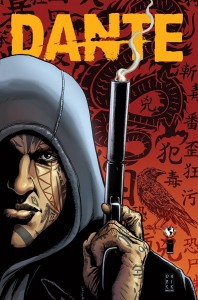 Chris Brunner; Colors: Rico Renzi
Chris Brunner; Colors: Rico Renzi
Of the independent-publisher debuts, Animosity: The Rise is a companion title to Marguerite Bennett’s series about what happens when all animals, from whales to birds to squirrels, suddenly gain sentience and the ability to talk: an animalpocalypse, of course. It covers the early days after the change, and is set on the West Coast instead of the main book’s East Coast — so, it’s Fear the Walking Dead, with the difference that there’s an actual connection between the two stories, since the main character here is the brother of the girl who’s traveling cross-country in Animosity. As long as you can get past the 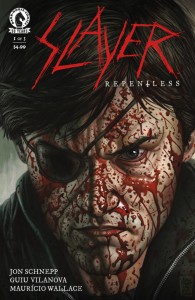 impossibility of the premise (which is what fantasy is all about, after all) it’s got some clever Animal Farm-ish social satire, and humor, mixed in with the inevitable violence. Dante is about a hitman who accidentally kills an innocent kid, whose ouraged grandmother curses him: he wakes up covered in tattoos that each represent one of the lives he’s ended, and has to try to atone for them, one at a time. This reminded me of something J. Michael Straczynski would write, with its solid premise and episodic nature (suitable for a TV series), and themes of morality and redemption; it’s helped considerably because the art is by Darick Robertson (Transmetropolitan,
impossibility of the premise (which is what fantasy is all about, after all) it’s got some clever Animal Farm-ish social satire, and humor, mixed in with the inevitable violence. Dante is about a hitman who accidentally kills an innocent kid, whose ouraged grandmother curses him: he wakes up covered in tattoos that each represent one of the lives he’s ended, and has to try to atone for them, one at a time. This reminded me of something J. Michael Straczynski would write, with its solid premise and episodic nature (suitable for a TV series), and themes of morality and redemption; it’s helped considerably because the art is by Darick Robertson (Transmetropolitan,  The Boys), who’s very good at both the gritty street-level violence and the supernatural elements, and whose slick realism makes readers feel like there’s really something at stake here. Slayer: Repentless is a comic based on the music of the heavy-metal group of the same name, based on an indy film trilogy; you either just said to yourself “That’s the coolest thing I’ve heard today; I need this comic” or “Who cares?” and, while there isn’t much here to convince members of the second group, if you’re in the first you should like it just fine. Lady Castle, as its name implies, is about a medieval, um, castle run by, um, ladies; the men have marched off on a crusade and got themselves killed, and now the women have to pull things
The Boys), who’s very good at both the gritty street-level violence and the supernatural elements, and whose slick realism makes readers feel like there’s really something at stake here. Slayer: Repentless is a comic based on the music of the heavy-metal group of the same name, based on an indy film trilogy; you either just said to yourself “That’s the coolest thing I’ve heard today; I need this comic” or “Who cares?” and, while there isn’t much here to convince members of the second group, if you’re in the first you should like it just fine. Lady Castle, as its name implies, is about a medieval, um, castle run by, um, ladies; the men have marched off on a crusade and got themselves killed, and now the women have to pull things 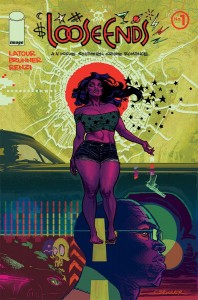 together, defend their home from various monsters, both human and not, and create a viable society. The first issue’s a bit Disney-ish, but it’s another book with a solid premise, and its heart is definitely in the right place; the girl-power theme is timely, and with a bit less earnestness, and a tad more snark and light humor, it could be another Castle Waiting. Loose Ends is written by Jason Latour, the artist and co-creator with Jason Aaron on Southern Bastards, and its got a similar Dixie milieu, and fondness for southern-fried noir; its cast of losers, drunks, bar-girls and criminals in this first issue promises a lot of violent, hard-boiled fun.
together, defend their home from various monsters, both human and not, and create a viable society. The first issue’s a bit Disney-ish, but it’s another book with a solid premise, and its heart is definitely in the right place; the girl-power theme is timely, and with a bit less earnestness, and a tad more snark and light humor, it could be another Castle Waiting. Loose Ends is written by Jason Latour, the artist and co-creator with Jason Aaron on Southern Bastards, and its got a similar Dixie milieu, and fondness for southern-fried noir; its cast of losers, drunks, bar-girls and criminals in this first issue promises a lot of violent, hard-boiled fun.
 Dept.H #10 — Writer/Artist: Matt Kindt; Colors: Sharlene Kindt
Dept.H #10 — Writer/Artist: Matt Kindt; Colors: Sharlene Kindt
Uber: Invasion #2 — Writer: Kieron Gillen; Art: Daniel Gete
Island #14 — Creators: Various
Dept.H continues its deep-sea murder mystery, with both its protagonist and the various supporting characters/suspects all trapped miles beneath the ocean; if you’re claustrophobic, the sweaty, walls-and-water-closing-in atmosphere may be particularly effective, although the delicate faux-primitive art helps, as does a long flashback that takes the character out of the  depths and back to her childhood. Uber: Invasion is an alternate-history tale imagining the Nazis discovering how to bestow super-powers on people toward the end of WWII, and thus changing the course of the conflict and leading to an invasion of the US. There are no shiny super-costumes, but a great deal of carnage; Gillen’s done a lot of historical research, and so the events feel realistic despite their fantasy quotient (the devastated Washington, DC scenes in this issue have deliberate echos of Hiroshima), and offer fascinating, if grim, entertainment. Island has made it to 14 issues — pretty good for an outsized, indy anthology — and this issue offers installments of Faryl Dalrymple’s Pop-Gun War; Liquid Shell, a post-
depths and back to her childhood. Uber: Invasion is an alternate-history tale imagining the Nazis discovering how to bestow super-powers on people toward the end of WWII, and thus changing the course of the conflict and leading to an invasion of the US. There are no shiny super-costumes, but a great deal of carnage; Gillen’s done a lot of historical research, and so the events feel realistic despite their fantasy quotient (the devastated Washington, DC scenes in this issue have deliberate echos of Hiroshima), and offer fascinating, if grim, entertainment. Island has made it to 14 issues — pretty good for an outsized, indy anthology — and this issue offers installments of Faryl Dalrymple’s Pop-Gun War; Liquid Shell, a post- apocalyptic funny animal/human manga mashup by Jess Pollard; Remy Boydell and Michelle Perez’s The Pervert, a quiet relationship drama with anthropomorphic transexuals; “The Crime of Iron,” by Troy Nixey, a lurid (and luridly colored) hardboiled/noir/sf short story about aliens who strip planets of their resources and destroy them; “Hotline to Death,” a wordless horror story with minimalist art that somehow makes it even more creepy; and “The Hunt,” a two-pager with some bite to it, by M.L. Macdonald. There’s the usual high production values and larger size to complement the art, and enough interesting cutting-edge talent to justify the $7.99 price.
apocalyptic funny animal/human manga mashup by Jess Pollard; Remy Boydell and Michelle Perez’s The Pervert, a quiet relationship drama with anthropomorphic transexuals; “The Crime of Iron,” by Troy Nixey, a lurid (and luridly colored) hardboiled/noir/sf short story about aliens who strip planets of their resources and destroy them; “Hotline to Death,” a wordless horror story with minimalist art that somehow makes it even more creepy; and “The Hunt,” a two-pager with some bite to it, by M.L. Macdonald. There’s the usual high production values and larger size to complement the art, and enough interesting cutting-edge talent to justify the $7.99 price.
 Steve Rogers, Captain America #10 — Writer: Nick Spencer; Art: Jesus Saiz; Ted Brandt and Ro Stein; Kevin Libranda; Colors: Rachelle Rosenberg with Jesus Saiz
Steve Rogers, Captain America #10 — Writer: Nick Spencer; Art: Jesus Saiz; Ted Brandt and Ro Stein; Kevin Libranda; Colors: Rachelle Rosenberg with Jesus Saiz
Civil War II: The Oath #1 (of 1) — Writer: Nick Spencer; Art/Colors: Rod Reis with Phil Noto, Rafaele Ienco, Szymon Kudranski and Dono Sanchez Almara
Marvel’s starting to ramp up to its spring Big Event series (well, one of them…), Secret Empire, which is stemming from events in the current volume of Captain America, where Steve Rogers has been Cosmic Cube/retconned into having been a sleeper Hydra agent since the ’30s; in  this week’s installment, he gets appointed director of S.H.I.E.L.D., the better to take over the country and the world. The Civil War II: The Oath one-shot follows directly from that issue, with the “oath” referring to the one he takes as he becomes director, and features Rogers confessing his plans to the comatose Tony Stark (and, thus, to us). Writer Spencer has done a good job keeping Cap’s character basically the same — even given his altered history and goals — and this new development might prove fun, assuming that it doesn’t get drawn out for too long (which, given Marvel’s recent history, might be a shaky assumption…).
this week’s installment, he gets appointed director of S.H.I.E.L.D., the better to take over the country and the world. The Civil War II: The Oath one-shot follows directly from that issue, with the “oath” referring to the one he takes as he becomes director, and features Rogers confessing his plans to the comatose Tony Stark (and, thus, to us). Writer Spencer has done a good job keeping Cap’s character basically the same — even given his altered history and goals — and this new development might prove fun, assuming that it doesn’t get drawn out for too long (which, given Marvel’s recent history, might be a shaky assumption…).
 Avengers #1.MU — Writer: Jim Zub; Art: Sean Izaakse; Colors: Frank D’Armata
Avengers #1.MU — Writer: Jim Zub; Art: Sean Izaakse; Colors: Frank D’Armata
Spider-Man/Deadpool #1.MU — Writer: Joshua Corin; Art: Tigh Walker; Colors: Rachelle Rosenberg
These are both spinoffs from last week’s Monsters Unleashed series, and are actually the first two chapters of a larger tale; the Avengers issue is about  Spider-Man and his super-friends fighting giant monsters in NYC, but then he disappears, and ends up entangled with Deadpool, and a Canadian boarding-school witches’ coven in Toronto — which is also facing a monster outbreak — in the second book. If you liked Monsters Unleashed #1, or are a big fan of Spider-Man, Deadpool, Spider-Man/Deadpool or all three, then you’ll probably like these too.
Spider-Man and his super-friends fighting giant monsters in NYC, but then he disappears, and ends up entangled with Deadpool, and a Canadian boarding-school witches’ coven in Toronto — which is also facing a monster outbreak — in the second book. If you liked Monsters Unleashed #1, or are a big fan of Spider-Man, Deadpool, Spider-Man/Deadpool or all three, then you’ll probably like these too.
 Moon Girl and Devil Dinosaur #15 — Writers: Brandon Montclare and Amy Reeder; Art: Ray-Anthony Height; Colors: Tamra Bonvillain
Moon Girl and Devil Dinosaur #15 — Writers: Brandon Montclare and Amy Reeder; Art: Ray-Anthony Height; Colors: Tamra Bonvillain
Spider-Woman #15 — Writer: Dennis Hopeless; Art: Veronica Fish; Colors: Rachelle Rosenberg
Both of these books fit comfortably into Marvel’s YA niche — Moon Girl and Devil Dinosaur, especially, with its nine-year-old title character (the girl, not the dinosaur…), its bright colors, and its empowering DIY, being-different-is-OK themes; this issue features a team-up with another new youngster, the 15-year-old Iron Man substitute Riri Williams, as, word having gotten around that Lunella is the smartest person in the world, an insulted Dr. Doom decides to take her down a peg (it’s the “old,” classic Doom, not the current one, but that seems to be a deliberate mystery, not a mistake). Lots of adventure and  charm, as always (look at that cover!), and a last-page guest star with enough buzz to bring us all back next issue. Spider-Woman’s last few issues have seemed to be going away from charm and into tragedy, but this issue shows those events were mostly a feint, at least temporarily, and end up leading to romance (one that’s been building since writer Hopeless began the previous volume of this series), and a big honking super-villain fight next issue; Veronica Fish has an art style that can handle the book’s 50/50 humor-drama combination capably, and this continues to be a quietly-good, under-the-radar comic; let’s hope its trade sales manage to keep it afloat.
charm, as always (look at that cover!), and a last-page guest star with enough buzz to bring us all back next issue. Spider-Woman’s last few issues have seemed to be going away from charm and into tragedy, but this issue shows those events were mostly a feint, at least temporarily, and end up leading to romance (one that’s been building since writer Hopeless began the previous volume of this series), and a big honking super-villain fight next issue; Veronica Fish has an art style that can handle the book’s 50/50 humor-drama combination capably, and this continues to be a quietly-good, under-the-radar comic; let’s hope its trade sales manage to keep it afloat.
 Hulk #2 — Writer: Mariko Tamaki; Art: Nico Leon and Dalibor Talajic; Colors: Matt Milla
Hulk #2 — Writer: Mariko Tamaki; Art: Nico Leon and Dalibor Talajic; Colors: Matt Milla
Totally Awesome Hulk #15 — Writer: Greg Pak; Art: Mahmud Asrar; Colors: Nolan Woodard
Black Panther #10 — Writer: Ta-Nehisi Coates; Layouts: Chris Sprouse; Finishes: Karl Story; Colors: Laura Martin
Doctor Strange #16 — Writer: Jason Aaron; Pencils: Chris Bachalo with Cory Smith; Inks: Al Vey, John Livesay, Victor Olazaba, Tim Townsend and Cory Smith; Colors: Antonio Fabela and Java Tartaglia with Chris Bachalo
 Hulk almost fits into the YA niche, too, but its longer-form storytelling (it’s clearly being written for the trade, given that its hero, Jennifer Walters, after two issues still hasn’t transformed into her big, green, and presumably now much more dangerous alter ego) and darker themes of PTSD, repression and anger push it more into the mainstream superhero category. The slow build isn’t bad, though, and even with its weightier story the style, law-office setting, and weird-client sub-plots will make it recognizable to fans of the book’s previous two incarnations; they, and patient newer readers, should be rewarded. Totally Awesome Hulk, as its name implies, is currently the sunnier gamma-spawned goliath; in fact, this issue, while it has a little bit of punching, is mostly a get-together between Amadeus, Ms. Marvel, Silk, Shang-Chi
Hulk almost fits into the YA niche, too, but its longer-form storytelling (it’s clearly being written for the trade, given that its hero, Jennifer Walters, after two issues still hasn’t transformed into her big, green, and presumably now much more dangerous alter ego) and darker themes of PTSD, repression and anger push it more into the mainstream superhero category. The slow build isn’t bad, though, and even with its weightier story the style, law-office setting, and weird-client sub-plots will make it recognizable to fans of the book’s previous two incarnations; they, and patient newer readers, should be rewarded. Totally Awesome Hulk, as its name implies, is currently the sunnier gamma-spawned goliath; in fact, this issue, while it has a little bit of punching, is mostly a get-together between Amadeus, Ms. Marvel, Silk, Shang-Chi 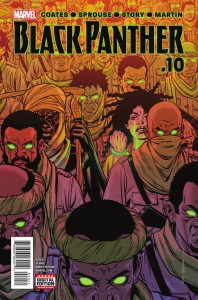 (the Master of Kung Fu), Jimmy Woo (head of the Agents of Atlas), and Jake Oh, a S.H.I.E.L.D. agent. What do they have in common? They’re all of Asian descent (which is why they’re all attending a benefit for sick kids, to encourage more bone marrow donors from that ethnic group), and the children of immigrants; the meat of the story is them eating at a Korean restaurant and talking about just what that means to them. Pak, who’s half-Korean, speaks from experience, and from the heart, and the result is both character-driven and educational; talking about how Asian kids are inspired by heroes who look like them helps to emphasize why Marvel’s gotten so much more diverse with their characters over the last few years, and why that’s a good thing. Black Panther‘s got some of that going on, too, with its title character having a good
(the Master of Kung Fu), Jimmy Woo (head of the Agents of Atlas), and Jake Oh, a S.H.I.E.L.D. agent. What do they have in common? They’re all of Asian descent (which is why they’re all attending a benefit for sick kids, to encourage more bone marrow donors from that ethnic group), and the children of immigrants; the meat of the story is them eating at a Korean restaurant and talking about just what that means to them. Pak, who’s half-Korean, speaks from experience, and from the heart, and the result is both character-driven and educational; talking about how Asian kids are inspired by heroes who look like them helps to emphasize why Marvel’s gotten so much more diverse with their characters over the last few years, and why that’s a good thing. Black Panther‘s got some of that going on, too, with its title character having a good 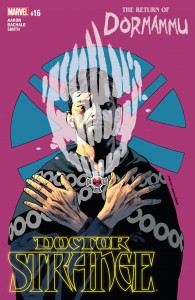 claim on being the first true African super-hero, and, after a kind-of-slow world-building start, this volume is moving along briskly, with revolution and rebirth among its themes, as T’Challa and Wakanda struggle to rebuild after all the destruction of the last few years of Marvel event battles, and to find their place in the modern world. Doctor Strange doesn’t really push diversity (although Wong gets treated as a lot more important than he used to be, and you might be able to argue for Wiccans as a minority…), but it’s been offering a breakneck pace and high-action, high-stakes plotting ever since this current run began; between Chris Bachalo’s detailed, dreamy art and Jason Aaron’s B-movie sensibilities and offbeat humor, it’s been one of the most consistently-entertaining books on the stands.
claim on being the first true African super-hero, and, after a kind-of-slow world-building start, this volume is moving along briskly, with revolution and rebirth among its themes, as T’Challa and Wakanda struggle to rebuild after all the destruction of the last few years of Marvel event battles, and to find their place in the modern world. Doctor Strange doesn’t really push diversity (although Wong gets treated as a lot more important than he used to be, and you might be able to argue for Wiccans as a minority…), but it’s been offering a breakneck pace and high-action, high-stakes plotting ever since this current run began; between Chris Bachalo’s detailed, dreamy art and Jason Aaron’s B-movie sensibilities and offbeat humor, it’s been one of the most consistently-entertaining books on the stands.
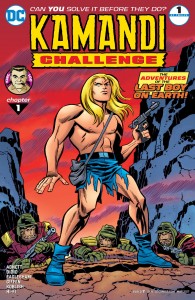 Kamandi Challenge #1 (of 12) — (Chapter 1) — Writer: Dan Didio; Art: Keith Giffen and Scott Koblish; Colors: Hi-Fi; (Chapter 2) — Writer: Dan Abnett; Art: Dale Eaglesham; Colors: Hi-Fi
Kamandi Challenge #1 (of 12) — (Chapter 1) — Writer: Dan Didio; Art: Keith Giffen and Scott Koblish; Colors: Hi-Fi; (Chapter 2) — Writer: Dan Abnett; Art: Dale Eaglesham; Colors: Hi-Fi
Odyssey of the Amazons #1 (of 6) — Writer: Kevin Grevioux; Pencils: Ryan Benjamin; Inks: Richard Friend; Colors: Tony Washington
Of the DC debuts, Kamandi Challenge is the most interesting: a callback to the ’80s DC Challenge, where a tag-team line of creators each worked on a chapter of an ongoing tale, providing a cliffhanger ending for the next team to solve, moving the plot forward, and then leaving another cliffhanger for the next team. In the ’80s, this worked better in theory than in execution, although the art, by people like Gene Colan and Curt Swan, was nice. So too here: this initial issue offers the beginning two chapters of the story, with the first featuring Keith Giffen and Scott Koblish doing their best gonzo Kirby imitations (as in the New 52 Omac), and retelling the origin of one of the King’s most offbeat creations: the Last Boy on Earth. The Kirby 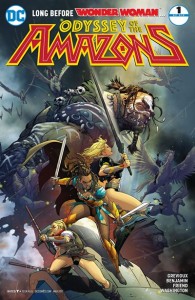 tributes abound, and add some needed heart to the proceedings, and the following chapter, by Dan Abnett and Dale Eaglesham, is clever and satisfying enough. Will the overall story hang together? Tune in for each succeeding issue, and we’ll see. Odyssey of the Amazons is set in the deep past of that group — so no Diana — and is basically a sword-and-sorcery saga with women warriors fighting various threats, in a barbarian world. Wonder Woman fans might like the hints of Amazonian history, but the real audience for this is readers who like Red Sonya; that fiery redhead would feel right at home with these fierce, take-no-crap-from-men fighters.
tributes abound, and add some needed heart to the proceedings, and the following chapter, by Dan Abnett and Dale Eaglesham, is clever and satisfying enough. Will the overall story hang together? Tune in for each succeeding issue, and we’ll see. Odyssey of the Amazons is set in the deep past of that group — so no Diana — and is basically a sword-and-sorcery saga with women warriors fighting various threats, in a barbarian world. Wonder Woman fans might like the hints of Amazonian history, but the real audience for this is readers who like Red Sonya; that fiery redhead would feel right at home with these fierce, take-no-crap-from-men fighters.
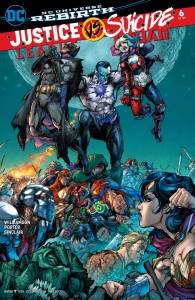 Justice League vs Suicide Squad #6 (of 6) — Writer: Joshua Williamson; Art: Howard Porter; Colors: Alex Sinclair
Justice League vs Suicide Squad #6 (of 6) — Writer: Joshua Williamson; Art: Howard Porter; Colors: Alex Sinclair
Suicide Squad #10 — Writers: Rob Williams and Si Spurrier; Art: Giuseppe Cafaro; Colors: Hi-Fi
Justice League of America: Killer Frost — Rebirth #1 (of 1) — Writers: Steve Orlando and Jody Houser; 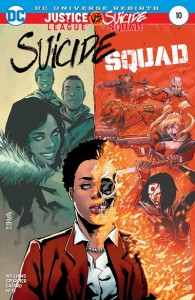 Art: Mirka Andolfo; Colors: Arif Prianto
Art: Mirka Andolfo; Colors: Arif Prianto
Justice League vs Suicide Squad has been something of a coming-out party for Joshua Williamson: all of those characters, all with clear relationships and motivations, and an escalating plot that started with the title fight, went through a number of cliffhangers and ante-uppers, and finishes 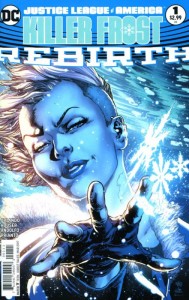 here with Max Lord, possessed by Eclipso, directing all the corrupted League and Squad against Batman, Lobo and Killer Frost. The fifteen-year-old in me thinks this is a great comic. Suicide Squad #10 is a coda to the main series, focusing on Amanda Waller, her kids, and a vengeful Rustam. Killer Frost comes right after that, as Waller tests Frost’s resolve before letting her out of prison to join the new Justice League of America with, of all characters, Batman and Lobo (and the Atom and the Ray and Vixen, who’ve already had their own “Rebirth” one-shots).
here with Max Lord, possessed by Eclipso, directing all the corrupted League and Squad against Batman, Lobo and Killer Frost. The fifteen-year-old in me thinks this is a great comic. Suicide Squad #10 is a coda to the main series, focusing on Amanda Waller, her kids, and a vengeful Rustam. Killer Frost comes right after that, as Waller tests Frost’s resolve before letting her out of prison to join the new Justice League of America with, of all characters, Batman and Lobo (and the Atom and the Ray and Vixen, who’ve already had their own “Rebirth” one-shots).
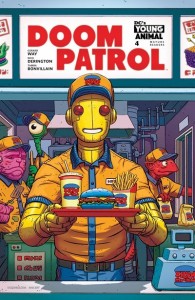 Doom Patrol #4 — Writer: Gerard Way; Art: Nick Derington; Colors: Tamra Bonvillain
Doom Patrol #4 — Writer: Gerard Way; Art: Nick Derington; Colors: Tamra Bonvillain
Deathstroke #11 — Writer: Christopher Priest; Art: Denys Cowan; Inks: Bill Sienkiewicz; Colors: Jeromy Cox
Doom Patrol has come together very nicely; the gaps between issues make it hard to appreciate each individual comic as much as we should, but read all together it’s a solid story, and is going to make a killer trade collection. One thing about Way is that he’s not just David-Lynch-randomly weird; everything eventually pays off, and when it all starts 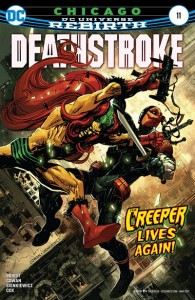 to come together, as here, it’s a lot of fun. Points for integrating so many elements of the old Morrison run so well with the new stuff, and for bringing back Crazy Jane, for at least one panel. That leaves Deathstroke, about as smartly written as it’s ever been, with dead-on guest appearances from the Creeper and his suitably-Ditkoesque civilian identity, Jack Ryder. Cowan and Sienkiewicz complement each other perfectly, the art hums with seedy atmosphere, and this is some of the best street-level mercenary suspense noir since The Question.
to come together, as here, it’s a lot of fun. Points for integrating so many elements of the old Morrison run so well with the new stuff, and for bringing back Crazy Jane, for at least one panel. That leaves Deathstroke, about as smartly written as it’s ever been, with dead-on guest appearances from the Creeper and his suitably-Ditkoesque civilian identity, Jack Ryder. Cowan and Sienkiewicz complement each other perfectly, the art hums with seedy atmosphere, and this is some of the best street-level mercenary suspense noir since The Question.



